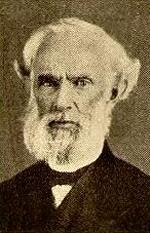Planning worship?
Check out our sister site, ZeteoSearch.org,
for 20+ additional resources related to your search.
- |
User Links
Person Results
Caroline L. Smith
1827 - 1886 Author of "Our heavenly Father, hear, In" Smith, Caroline Louisa, née Sprague, was born at Salem, Massachusetts, and married to the Rev. Charles Smith, pastor of the South Congregational Church, Andover. Mrs. Smith is the author of:—
Tarry with me, O my Saviour. An Old Man's Prayer. Mrs. Smith's account of this hymn is "About the year 1853 [in the summer of 1852], I heard the Rev. Dr. H. M. Dexter preach a sermon on 'The Adaptedness of Religion to the Wants of the Aged.' I went home and embodied the thought in the hymn 'Tarry with me, 0 my Saviour!' I sent it to Mr. Hallock, for The Messenger. He returned it as 'not adapted to the readers of the paper.' Years after I sent it, without any signature, to the little Andover paper .... I send it to you in its original form, in a little paper of which my sister, Mrs. Terry [Rochester, N.Y.], is editoress." (Hatfield's Poets of the Church, N.Y., 1884, p. 564.) Hatfield gives the full text in 1 stanza of 6 lines. In the Plymouth Collection, 1855, No. 1337, in 5 stanzas of 4 lines, was compiled from st. i., ii., vi., vii. This was repeated in The Sabbath Hymn Book, 1858, and others. Of this text st. ii. is sometimes omitted.
--John Julian, Dictionary of Hymnology (1907)
Caroline L. Smith
Ludwig van Beethoven

1770 - 1827 Person Name: Beethoven Composer of "[Father in heav'n, Hear thou our earnest prayer]" in The Beacon Hymnal A giant in the history of music, Ludwig van Beethoven (b. Bonn, Germany, 1770; d. Vienna, Austria, 1827) progressed from early musical promise to worldwide, lasting fame. By the age of fourteen he was an accomplished viola and organ player, but he became famous primarily because of his compositions, including nine symphonies, eleven overtures, thirty piano sonatas, sixteen string quartets, the Mass in C, and the Missa Solemnis. He wrote no music for congregational use, but various arrangers adapted some of his musical themes as hymn tunes; the most famous of these is ODE TO JOY from the Ninth Symphony. Although it would appear that the great calamity of Beethoven's life was his loss of hearing, which turned to total deafness during the last decade of his life, he composed his greatest works during this period.
Bert Polman
Ludwig van Beethoven
Love H. Jameson

1811 - 1892 Author of "Our Father in heaven, In mercy now hear us" Born: April 17, 1811, Jefferson County, Indiana.
Died: April 12, 1892, Indianapolis, Indiana.
Buried: Crown Hill Cemetery, Indianapolis, Indiana.
Love Humphreys Jameson was born in Jefferson County in what was then the Territory of Indiana on May 17, 1811, the son of Thomas Jameson. Thomas had moved from Virginia to Kentucky around 1800 and later to the Indiana Territory in 1810 or early 1811. Thomas’s parents were members of the Calvinistic Kirk of Scotland and his wife’s parents held the views of the Church of England, but the family became Christians in 1816 with Love’s father and mother being baptized by John McClung, a young associate of Barton Warren Stone. Love, whose education was attended with all the difficulties associated with frontier life and was mostly under the tuition of his parents, was baptized in the fall of 1829 during a protracted meeting with Beverly Vawter and then preached his first sermon that same year on Dec. 25, following which he began preaching the gospel regularly.
From 1830 to 1834, Jameson taught school during the winters and made preaching trips in the summers. One of his mentors was Walter Scott, with whom he frequently travelled and worked. Moving to southern Ohio, in 1834, he, along with Scott, attended the famous debate of 1837 between Alexander Campbell and Bishop Purcell at Cincinnati, OH. In addition, he wrote frequently for Campbell’s paper, The Millennial Harbinger, in which Campbell spoke of him as the brother “whose praise is in all the churches in Indiana.” After preaching at various churches in Hamilton County, OH, Jameson worked with the church in Dayton from 1835 to 1837, when he married Elizabeth M. Clark. Also, in the closing years of B. W. Stone’s life, Jameson often accompanied the elderly preacher on his journeys. In 1840 he returned to Indiana and located at Madison, IN, the following year. His wife died of an apoplectic stroke suddenly soon afterwards, and he married Elizabeth R. Robinson in 1842, moving to Indianapolis, IN, which became his headquarters for the rest of his life.
In 1845, Jameson was asked, along with John O’Kane, to evangelize in the southwestern part of the state. Then after 1854, he made regular preaching trips into Ohio, Kentucky, Western Missouri, Illinois, New York, and even portions of New England. “There is a Habitation” was penned about 1860, with both words and original music by Jameson, but it never achieved any degree of popularity because of its slow, ponderous, torpid melody. The song as we know it was first published under the title, “O Sion, Sion,” in the New Christian Hymn and Tune Book, Part II, compiled at Cincinnati, OH, in 1882 by James Henry Fillmore. Jameson, who also provided the lyrics for “Night, With Ebon Pinion,” died ten years later, on May 1, 1892, in Indianapolis.
--hymnstudiesblog.wordpress.com
Love H. Jameson
C. V. Strickland
Person Name: C. V. S. Composer of "[Hear our pray'r, Father in heav'n]" in Priceless Pearls
C. V. Strickland


 My Starred Hymns
My Starred Hymns


